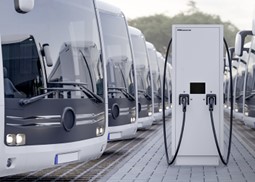- Country: Sweden
- Sector: Buses
- Area of Action: Urban transport
- Type of service: Municipality/public service
- Power source: Electric
- Aspects described in the case study:
- Technical features of e-buses and actual developments
- Charging infrastructure construction and operation
- Digital solutions assisting the use and operation of e-buses
- Training of e-bus drivers
- Training of e-bus maintenance staff
- Eco driving
- Health and business environment of e-bus driving
CONTEXT
The Stockholm Sustainable Mobility Plan, located in a large and densely populated city in Sweden, is an outstanding example of technical implementation in urban transport. This plan includes the electrification of buses, not only as a pilot project, but as a full roll-out across the entire transport network by 2030. The decision to make this transition is based on the need to reduce CO2 emissions and other pollutants. Stockholm has already managed to operate its metro network, buses and local trains with 100% renewable energy since 2017. With the introduction of electric buses, the city hopes to improve air quality, reduce energy consumption and lower noise levels, aligning with its goal of being a carbon neutral city by 2030.

THE PROCESS
- Planning and Investment: The SMP started in 2017 with an initial investment of SEK 50 million (approximately EUR 5.7 million) for strategic planning and needs assessment. Clear targets were set to reduce CO2 emissions by 40% by 2025 and 80% by 2030 compared to 1990 levels.
- Infrastructure Development: More than 150 kilometers of safe bicycle lanes have been built and 500 electric vehicle charging stations have been installed throughout the city. In addition, 100 bus stops have been upgraded to make them accessible and environmentally friendly.
- Technology Integration: The city implemented advanced traffic management systems that use real-time data to optimize travel times and reduce congestion. More than 300 traffic sensors have been installed and artificial intelligence algorithms are used to improve traffic flow in key areas.
- Training Programs and Awareness Campaigns: More than 50 training workshops were conducted for municipal employees and more than 10,000 citizens were reached through educational campaigns at schools, universities and community events. These initiatives have actively promoted the use of sustainable modes of transportation such as bicycles and public transportation.

IMPACT
- Environmental Benefits: Since the implementation of the SMP, Stockholm has achieved a 35% reduction in CO2 emissions and significantly improved air quality. It is estimated that more than 100,000 tons of CO2 are avoided each year thanks to the increased use of electric vehicles and bicycles.
- Operational Efficiency: The SMP has reduced travel times by an average of 15% in the most congested urban areas, improving the efficiency of public and private transportation. This translates into economic savings and increased satisfaction among transport users.
- Public Health: The public health benefits are significant, with a 25% decrease in respiratory diseases related to air pollution. In addition, a 20% increase in the use of bicycles as a primary mode of transportation has been observed, improving residents’ physical activity and cardiovascular health.
- Economic Growth: Investment in sustainable infrastructure has generated more than 500 new direct jobs in the green mobility sector and has attracted additional investments of more than SEK 100 million (approximately USD 11.4 million) in clean transport and green technology projects.
Training and Skills Development: Training programs have significantly increased awareness of sustainable mobility among municipal employees, improving their skills in handling advanced technologies and efficient resource management. More than 5,000 people have actively participated in these programs, strengthening the community’s capacity to address long-term sustainable urban mobility challenges.
MORE INFORMATION
During the investigation of the Stockholm Sustainable Mobility Plan, effective collaboration between local government, private companies and the civil community was observed, which was fundamental to its successful implementation. In addition, favorable national policies, such as incentives for electric vehicles, have provided crucial financial support for this plan. Nevertheless, challenges such as resistance to change and the need to adapt to fluctuations in urban transport demand were faced. These aspects highlight the importance of flexibility and active participation of all stakeholders to ensure the long-term sustainability of similar initiatives in other cities and regions.
MULTIMEDIA
Sources:
https://www.urban-transport-magazine.com/wp-content/uploads/2020/11/Barkarbystaden_20-24.jpg
https://www.sustainable-bus.com/wp-content/uploads/2024/02/Screenshot-2024-02-20-alle-12.24.25.png
Videos:
Relevant links:
